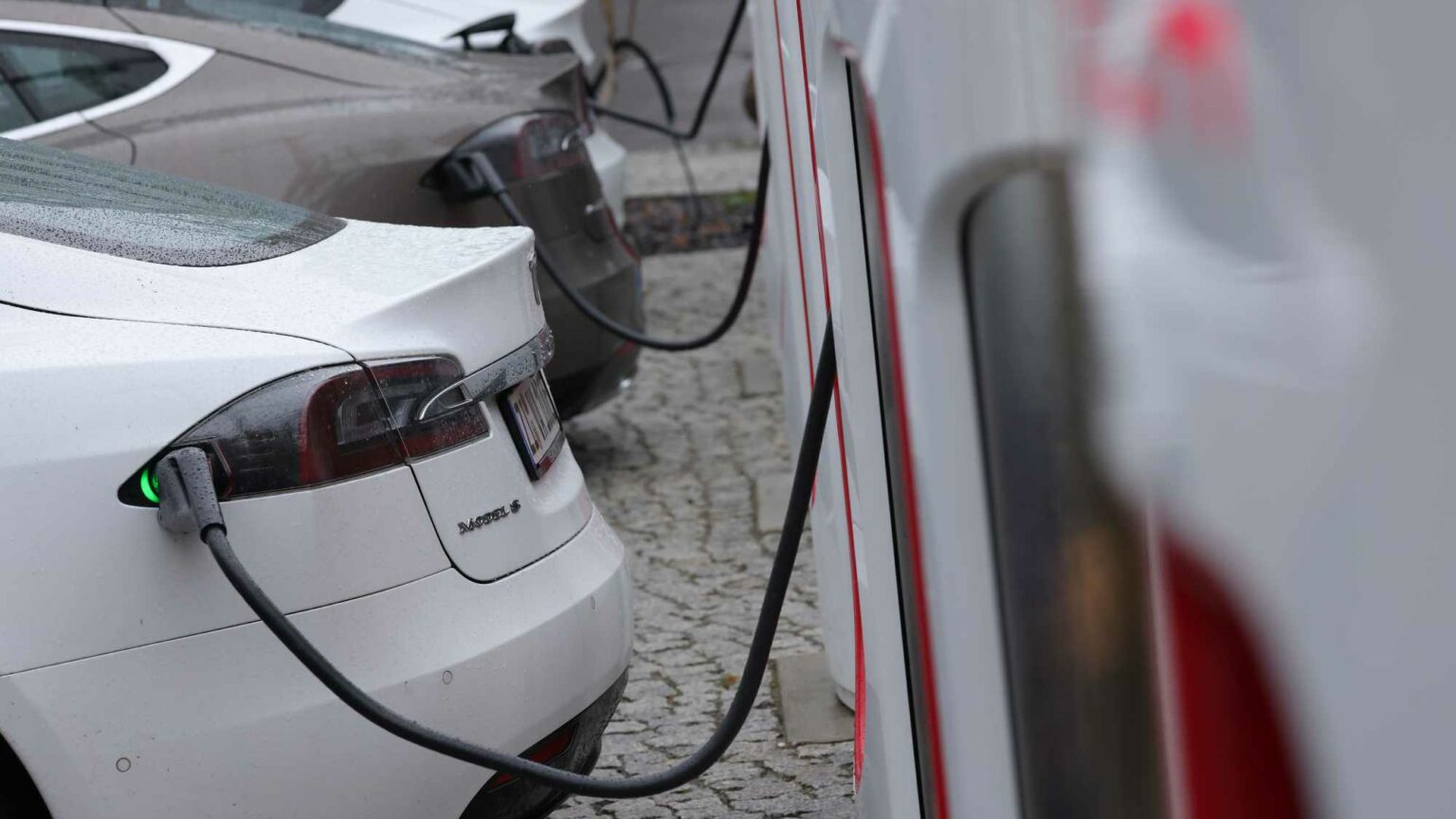The truth about electric cars
They are far more environmentally damaging than normal cars.

Want to read spiked ad-free? Become a spiked supporter.
A cargo ship called the Felicity Ace, carrying 4,000 luxury cars collectively worth around $438million, caught fire last month. Thankfully, the crew members were not harmed and managed to quickly abandon ship. The fire, however, burned for a week. This was because the lithium-ion batteries inside the electric vehicles (EVs) in the consignment kept the fire alive. The fire only died once the supply of combustible material on board was exhausted.
Something similar happened in July last year. In Victoria, Australia, a 13-tonne Tesla ‘Megapack’ facility – which uses a vast array of lithium-ion batteries to store energy generated by intermittent renewables – caught fire. This fire eventually burned itself out after three days. In that time, it created numerous ecological hazards, including toxic smoke, which engulfed local residents. But firefighters could do little more than monitor the environmental damage – they had to wait for the fire to put itself out.
‘The most significant danger of a lithium-ion battery is that [fires] are almost impossible to put out once they are ignited’, notes engineer Robin Mitchell. ‘No matter how many safety systems are put in place’, he says, ‘a fire started by a lithium-ion battery is far too challenging to manage’. Such technology, Mitchell concludes, ‘may only be suitable for small-scale systems such as smartphones and EVs’. Even so, the fire risks posed by EV batteries are not insignificant.
Most of us carry a lithium-ion battery in our smartphone without thinking about it, and these are relatively safe. The danger of using larger lithium-ion batteries in larger configurations has been recognised by authorities since their commercial introduction in 1991. For instance, US airlines do not permit laptops with integrated batteries larger than 100 watt hours on board. The likelihood of the battery catching fire is relatively low. But in the event of a fire, to extinguish it, you can’t use water. The fire risks are even greater for an EV, which is a bit like a tightly packed sandwich of hundreds of laptop batteries.
So, what are our environmental campaigners doing to draw our attention to this great new hazard? You may have noticed a curious absence of Change.org petitions, hashtags or alarming reports from the likes of BBC News.
This is even more surprising when you consider the ecological damage and exploitation that goes into producing the batteries. Lithium extraction is filthy and it uses huge amounts of groundwater. In Chile, mining activities in the Salar de Atacama region consume 65 per cent of the area’s water. Toxic chemicals from the mining process have been known to leak into water supplies. Researchers in Nevada found that fish as far as 150 miles downstream were being impacted by mining operations.
Lithium-ion batteries also need a lot of cobalt – typically around 14kg per car battery. Extracting this is dirty and dangerous. In the Democratic Republic of Congo, the world’s largest supplier, children as young as seven wash and sort ores as ‘artisanal miners’, according to an Amnesty report from 2016.
This, then, is an environmental story that has failed to make the usual species leap from academic researcher to NGO media campaigner to TV news producer. This is odd, given that the precautionary principle has been a staple of environmentalist campaigning for five decades now. For instance, shale-gas exploration cannot proceed, green activists argue, because fracking risks causing ‘earthquakes’, even though these tend to be largely imperceptible. Yet when it comes to EVs and lithium-ion batteries, the precautionary principle seems to have been laid to rest for a while.
The dangers of lithium-ion batteries are evident in the number of high-profile product recalls. Dell recalled four million batteries in 2006. HP recalled more than 100,000 laptops in 2019 because of battery-fire risks. After causing fires on flights, Samsung’s Note 7 smartphone was recalled – twice – and then sidelined completely.
The costs and risks only increase with larger products. Fires originating in the battery in Chevrolet Bolt vehicles are estimated to have cost General Motors around $2 billion. Audi had to recall its E-Tron SUV for the same reason. Parked Teslas keep bursting into flames – and the company has been castigated for not recalling the vehicles.
Instead of exposing this great environmental danger, the BBC can be found promoting the batteries. ‘There’s no doubt that batteries are central to a low-carbon future’, a recent film in its ‘Ideas’ series explained. ‘Lithium-ion batteries can store clean energy for when the sun isn’t shining and the wind isn’t blowing, sending it out on grey days with the strength and reliability that rivals fossil fuels.’ Hurray!
Even more curious is that the green priesthood has blessed lithium-powered EVs as an ‘environmentally friendly’ successor to vehicles powered by the internal combustion engine (ICE). The argument is that since EVs do not use an ICE, which is powered by an oil derivative (petrol or diesel), driving them results in lower CO2 emissions.
Yet last week, Britain’s most popular car YouTuber, Tim Burton (more widely known as Shmee), announced that he was replacing his electric Porsche with a petrol-powered Ferrari V12 – because it’s greener and cleaner. His reason may surprise many who believe that EVs are either ‘low’ or ‘zero’ CO2-emission vehicles.
Burton cited a study that Volvo released during the COP26 climate summit. This study, led by Andrea Egeskog of the Sustainability Center at Volvo, received remarkably little attention at the time. Volvo is unusual in being able to make direct comparisons between two versions of the same car model, the XC40 SUV. One is electric, the other has an ICE. Volvo calculated the CO2 emissions over the full lifecycle of the two products: from mining the minerals, like lithium and cobalt, to the end of their lives, including disposal.
Out of the factory gate, the electric car begins its life on the wrong side of the tracks – having generated far more CO2 than the petrol-guzzling version. That’s because of lithium and the other rare-earth minerals required to manufacture the ‘planet-saving’ EV. The emissions from the materials and the production of the ICE version of Volvo’s XC40 are roughly 40 per cent lower than for the EV.
Of course, the ICE model continues to consume fossil fuels for as long as it’s in use. But for the electric version to ‘break even’, so to speak, it has to do a lot of miles on the clock. Its eco-friendliness also depends enormously on how the electricity used to charge the batteries is generated. Volvo advises that, based on a typical global energy mix, if you drive under 93,000 miles you will cause greater emissions by choosing an electric vehicle over the petrol version. In the EU, which uses a higher proportion of renewables, the break-even point is still 52,000 miles. Hence Burton’s decision to return his EV. A high-performance Ferrari or Porsche car will never achieve such mileage. Nor will a normal car like mine. If I replace my 19-year-old car tomorrow, and take the ‘green option’ instead of the petrol option, I will be poorer, because the EV equivalent is so much more expensive, and it will only finally start to achieve CO2-emissions savings over the petrol rival some time in the late 2040s. But it won’t ever reach that point, as the battery will be depleted long before then.
Despite all this, the major car manufacturers have ploughed billions into the development of EVs. EVs have also been heavily subsidised by governments as a means to achieve their climate goals. ‘What if those billions of dollars had been put into the internal combustion engine, how much better would they have got?’, Burton muses.
Many of the EVs sold today are ‘urban runabouts’ – that is, vehicles that will never reach the CO2 ‘break even’ point, and will therefore emit more CO2 than a petrol equivalent. Since the practical value of an EV today in reducing CO2 emissions is zero, its value is merely to signal moral superiority, showing others that you care and they don’t. It is a status good. It makes the owner feel better.
The curious moral of the story is that, even by their own standards, environmentalists aren’t terribly good at practising what they preach. If, as climate change campaigners insist, our cars are ‘killing the planet’, then it’s the virtuous among us who are killing the planet faster. That such hypocrisy from the green elites has gone unchallenged for so long is remarkable. It surely can’t last.
Andrew Orlowski is founder of the research network Think of X and a columnist at the Telegraph.
Picture by: Getty.
Who funds spiked? You do
We are funded by you. And in this era of cancel culture and advertiser boycotts, we rely on your donations more than ever. Seventy per cent of our revenue comes from our readers’ donations – the vast majority giving just £5 per month. If you make a regular donation – of £5 a month or £50 a year – you can become a and enjoy:
–Ad-free reading
–Exclusive events
–Access to our comments section
It’s the best way to keep spiked going – and growing. Thank you!








Comments
Want to join the conversation?
Only spiked supporters and patrons, who donate regularly to us, can comment on our articles.